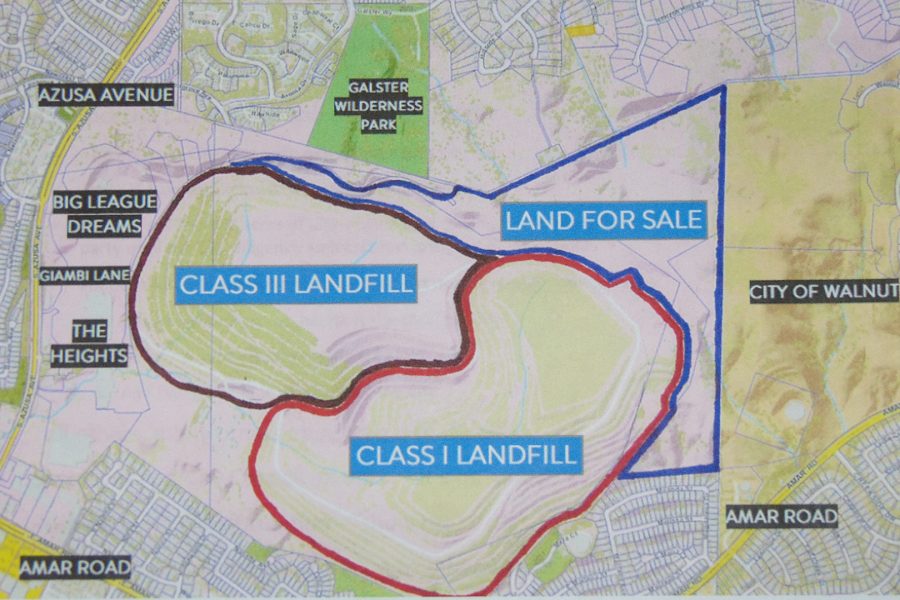At the informational session, Brian Jobst gave a brief history of the BKK Landfill. He said he could give a whole presentation on the history of BKK alone, but decided to focus on the highlights, which he said could be nicknamed the lowlights.
From 1950 until 1963, West Covina was the fastest growing city in the country, and some said it was the fastest in the world. The city that was almost renamed Fleetwood in 1948-1949 grew 1,000 percent from 5,000 people to 50,000 people.Documents from around 1960 show that city hall was concerned about getting revenue, and two other parties needed revenue as well.
Where the BKK Landfill is today was originally owned by Home Savings & Loan. They could not sell a stick of the land during the largest real estate boom of the time because of its large steep ravines.
Jobst posited the question of when that land could be sold if it couldn’t be sold in the biggest boom.The remaining party is the landfill’s name sake, the BKK Corporation, who owns landfills all over Southern California. They found trash to be a lucrative business and were looking for additional locations.
So in February 1963, the West Covina City Council created the BKK landfill. The lead up to this decision included the attorney for Home Savings & Loan saying that trash will fill the “unsightly ravines.” The council at the time said a park would be built on top of the dump once it was filled, despite opposition from residents. They granted a 130 acre permit for 12 years and soon after the BKK Corporation assumed operation of the dump, leasing the property.
December 1968: Regulatory agencies allowed hazardous waste to be disposed in the BKK landfill. Records do show that one regulatory agency may have dumped their first load in 1967, but the amount of hazardous waste handled remained small until 1975.
January 1971: The West Covina Planning Commission expanded the landfill to 583 acres and the permit to 30 years. BKK Corp. does not want to donate the property, and said it cannot afford to buy and give away land costing $2 million to $3 million.
April 1974: The council reports there are growing complaints of odors.
June 1976: The council extends the dump permit 30 years and abandons demand for title of property. Instead city imposes tax on gross receipts, raising $110,000 in the first year, and $2 million a few years later.
December 1978: Dump opposition grows, over 900 residents sign petitions demanding BKK control odors. Council instructs planning commission to hold hearings to revoke the permit unless odors are stopped.
During 1978, BKK Corp. acquires ownership of 583-acre dump and 471 adjoining acres in Walnut. Along with an additional West Covina parcel their acreage is raised to 1,200 acres.
November 1980: Homeowners announce they will file a lawsuit, and circulate petitions. BKK becomes the only remaining landfill for hazardous waste from the Santa Barbara County to the border.
July 1984: They found registered levels of methane gas and vinyl chloride, a known carcinogen, at 100 times the safe limit. As they found this out, 21 families were evacuated and some couldn’t return for five or six months.
The lawsuit was settled in 1986 with 508 residents sharing a $43 billion settlement, the largest landmark settlement for the time.
In 1996 after additional lawsuits, BKK finally closes. The Class I and Class III landfills are owned by BKK, but the company is completely bankrupt and only exists on paper. Still BKK is the legal owner on record.
In the last 18 months, Jobst has researched the situation and assessed that one message is clear – this is about money.He said his major concern was to not have history repeat itself, and said the number one priority for BKK should be public health.
Still they shipped contents of the Stringfellow Acid Pits superfund site to BKK. The superfund site that shipped to BKK was part of the Comprehensive Environmental Response, Compensation, and Liability Act of 1980, otherwise known as the Superfund Act.
CERCLA’s first action was to address the Stringfellow Acid Pits of Riverside, California.This was years after an accident where a breakage led to a leak. Contaminated acids flowed out and evaporation pods leaked or broke.
The EPA addressed the situation by shipping the contaminated soil out. They sent truck after truck of hazardous soil into West Covina.
This caused problems for the EPA, and there were Congressional hearings held to change processes.The only reason BKK has not been classified as a Superfund site is because people are willing or able to pay for the cleanup or maintenance of the site. It meets the other two requirements of being big and bad. The taxpayers do not have to pay for the hazard because of the Potentially Responsible Parties and their agreement with the DTSC to keep the area safe.
Information was aggregated by Brian Jobst in the presentation and further Los Angeles Times articles provided a stronger timeline of events.




Jeanine • Nov 13, 2023 at 10:02 am
How about the compensation for residents that were children at the time who have been affected with cancer from growing up there? Can I still get compensation for health issues?